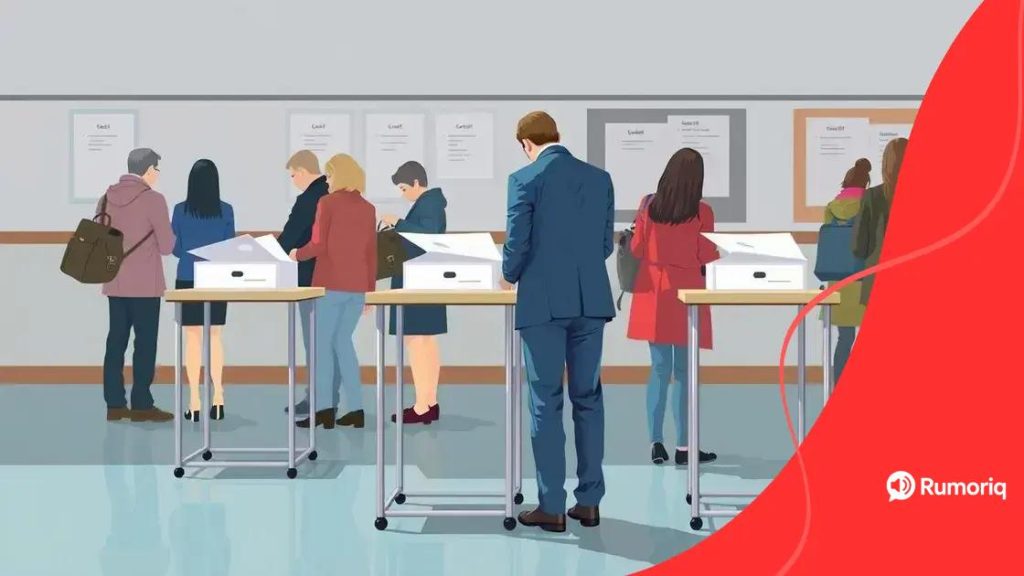2025 midterm election predictions you should know

Anúncios
The 2025 midterm election predictions indicate significant influence from key issues like economic stability, emerging candidates, and recent political events, all of which can lead to unexpected outcomes and shifts in voter sentiment.
2025 midterm election predictions are already sparking conversations about the future of American politics. What factors will influence voter behavior? Let’s dive into the key elements that could shape the results.
Anúncios
Key issues shaping the 2025 midterms
The political landscape ahead of the 2025 midterms is already crowded with important issues that voters care about. Understanding these key issues can provide insight into what drives voter decisions.
Economic Challenges
One of the highest priorities for voters is the economy. Inflation, job growth, and wage stagnation will likely shape opinions. As the economy goes, so do election outcomes. Voters will be examining government measures to ensure economic stability and growth.
- Inflation rates and their impact on daily life
- Job creation and unemployment statistics
- Government policies affecting wages
Another significant issue is healthcare, with many Americans still concerned about affordability and access. The cost of healthcare can influence how voters feel about their current representatives.
Anúncios
Social Justice Movements
Issues surrounding social justice will also play a crucial role. Voters are looking at how candidates address topics like racial equality, police reform, and LGBTQ+ rights. Progress in these areas can energize specific voter demographics.
- Impact of recent legislation on civil rights
- The rise of grassroots movements
- Candidate positions on social reform
Lastly, environmental concerns are rising to the forefront, especially in light of recent climate-related events. Candidates who advocate strong environmental policies may draw significant support from younger voters.
Climate change initiatives and sustainability practices are hot topics. Voters want to know how candidates plan to protect the planet while ensuring economic growth.
Key Factors Influencing Voter Behavior
Education will also be a crucial issue as schools and universities face challenges. Voters are interested in how candidates plan to support students and educators.
- Funding for public education
- Student loan debt relief programs
- Teacher pay and support initiatives
By focusing on these key issues, voters can make informed decisions in the upcoming election, influencing the overall political landscape.
Predicted voter turnout trends
The predicted voter turnout trends for the 2025 midterms are drawing significant interest among analysts and political enthusiasts. Understanding these trends can help predict party performance and electoral shifts.
Historical Patterns
Looking at past elections, we see patterns. Voter turnout often varies based on the stakes perceived by the electorate. In midterm elections, turnout typically lags behind presidential elections.
- Historically, midterm elections see about 40% turnout.
- In high-stakes years, such as 2018, turnout spiked significantly.
- Demographics play a strong role in turnout variations.
This time, issues driving people to the polls, such as the economy and social justice matters, could influence turnout positively.
Demographic Influences
Furthermore, we can anticipate specific demographics will have varied impacts on turnout. For instance, younger voters, previously less participative, are becoming more engaged due to pressing social issues.
- Millennials and Gen Z tend to prioritize climate change.
- Women voters have shown increasing turnout related to reproductive rights.
- Minority groups are mobilizing around civil rights.
The key will be how campaigns resonate with these voters and motivate them to cast their ballots. Voting accessibility is also crucial; states enacting laws to ease the voting process may see higher turnout.
Additionally, the atmosphere surrounding the elections, including national campaigns and activism, will contribute to turnout rates. If excitement builds around key candidates and issues, this can drive more people to participate.
Analyzing predicted trends reveals a complex picture where numerous factors influence voter decisions. The landscape for turnout in the 2025 midterms appears to be evolving.
Impact of recent political events

The impact of recent political events on the upcoming 2025 midterm elections cannot be overstated. Major events have altered the political landscape, influencing voter sentiments and party dynamics.
Legislative Changes
New laws and policies passed in recent months have reshaped key issues like healthcare, immigration, and voting rights. These legislative actions motivate voters to engage in the political process.
- Healthcare reforms aim to expand access, changing public opinion.
- Immigration policies could affect demographics and voter turnout.
- Voting rights legislation can mobilize specific voter groups.
As these laws take effect, candidates will need to address their implications, responding to constituents’ concerns and desires.
Public Response to Events
Recent protests and national movements have also galvanized support for specific causes. As public awareness grows about issues such as gun control and climate change, candidates may find themselves pressured to take firm positions.
- Gun control advocacy has intensified after recent tragedies.
- Environmental movements are pushing for stronger policies.
- Social justice campaigns mobilize voters from diverse backgrounds.
These events show that the political environment is ever-changing. Candidates must be responsive to the voices in their communities, reflecting the desires of their constituents to gain support.
The role of media cannot be overlooked either. How politicians present themselves during these events can greatly affect their public perception. Voters are seeking authenticity and accountability.
Internally, parties may also experience shifts due to controversies or successes in handling these events. For instance, strong performances can unite party members, while failures might lead to fractures.
Understanding the impact of recent political events will be crucial as we approach the 2025 midterms. Candidates that can effectively communicate their responses to these issues may have the advantage on Election Day.
State-by-state election forecasts
The state-by-state election forecasts are essential for understanding how the 2025 midterm elections might unfold. Each state presents unique challenges and opportunities that can significantly affect overall results.
Key Battleground States
Your attention should focus on key battleground states. These are often pivotal in determining which party gains control of Congress. States like Pennsylvania, Arizona, and Wisconsin are closely watched for trends.
- Pennsylvania has seen shifts in its electorate, with growing urban areas influencing voting behavior.
- Arizona’s changing demographics have made it a hotly contested state.
- Wisconsin remains a classic swing state, often reflecting national trends.
These battlegrounds will likely receive heavy campaigning as candidates tailor their messages to local concerns.
Trends and Predictions
Factors influencing state outcomes include local issues, recent events, and economic conditions. In some areas, healthcare may dominate discussions, while in others, the focus may be on education or public safety.
- States affected by natural disasters may prioritize climate change discussions.
- Economically troubled areas will certainly highlight job creation efforts.
- Voting rights and election integrity concerns can also mobilize voters.
It is vital for campaigns to understand these nuances. Ignoring local sentiments could alienate potential supporters.
Polling data becomes crucial as the election approaches. Regularly updated information reveals where candidates stand and how voters are leaning. Monitoring these trends can provide insight into shifting dynamics.
Moreover, turnout rates among different demographics will play a central role. Many states have varied voter bases, including young voters, minorities, and seniors. Engaging these groups may turn the tide in close races.
As we look at state-by-state election forecasts, it is clear that every single vote counts. Candidates must strategically allocate their time and resources to the states where they can make the most significant impact.
Potential upsets and surprises
The potential upsets and surprises in the 2025 midterm elections could change the political landscape drastically. Many voters are eager to see how unexpected events might influence the election outcomes.
Emerging Candidates
In recent elections, new and emerging candidates have shocked the political scene. These fresh faces may capture the attention of voters by addressing issues that resonate deeply.
- Candidates from diverse backgrounds can bring unique perspectives.
- Grassroots movements often support these emerging leaders.
- Voter engagement can spike with exciting new narratives.
Watching how these candidates perform in early primaries will be essential to gauging their potential impact on the overall election.
Shifts in Voter Sentiment
Unanticipated events can cause significant shifts in voter sentiment. A major scandal, economic downturn, or social movement might alienate or rally voters. These elements can alter expectations dramatically.
- Recent policy changes may unearth dissatisfaction among key voter groups.
- Public opinion on contentious issues can sway quickly.
- Media coverage can influence perceptions significantly.
Candidates must be prepared to adapt their messaging in response to these changes. They will need to stay attuned to what issues resonate most with the public.
Also, special elections between now and 2025 could indicate broader trends. Upsets in local races can be early indicators of a wave of change. They provide important insights into how different demographics may respond to national candidates.
As we approach the election, analysts will closely monitor these upsets and surprises. They will examine polling data, social media trends, and community engagement to predict how these dynamics will play out.
Voters are continuously evolving, and their preferences may not align neatly with party lines. This unpredictability adds an exciting layer to the 2025 midterms.
FAQ – Frequently Asked Questions about the 2025 Midterm Elections
What are the key issues influencing the 2025 midterm elections?
Key issues include economic stability, healthcare, social justice movements, and voter rights.
How might recent political events impact voter turnout?
Recent political events can shift voter sentiment and engagement, leading to increased or decreased turnout depending on public response.
What role do emerging candidates play in the election?
Emerging candidates can surprise traditional candidates by addressing new concerns and capturing the interest of voters.
Why is polling data important as the election approaches?
Polling data provides insights into voter sentiment and trends, helping campaigns adjust their strategies effectively.